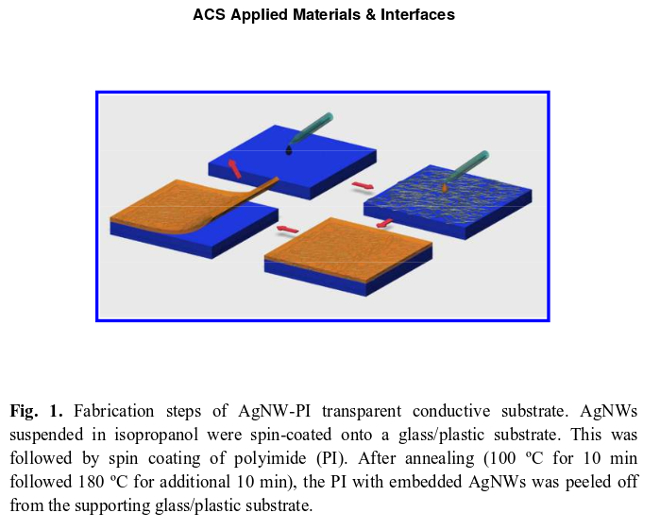The website of the American Chemical Society (ACS) recently published an article on "Ultra-thin transparent conductive polyimide film with embedded silver nanowires" by Spain-based scientists Dhriti Sundar Ghosh, Tong Lai Chen, Vahagn Mkhitaryan, and Valerio Prunéri.
Result: Free-standing TCs with improved properties
Thin transparent conductors (TC = Transparent Conducotors), which offer both high electrical conductivity and optical transmission, have always been of great importance for electronic devices and photon devices such as photovoltaic cells, touch screen displays and organic light-emitting diodes (OLEDs).

The work deals with an experiment in which free-standing TCs (transparent conductors) together with their improved properties and all solution process methods are prepared from AgNWs (Ag Nanowires) embedded directly in a PI substrate. The resulting conductive substrate has a value > 90% (550 nm) for TOPT, RS is as low as 15 ohms/sq, it is mechanically flexible, and provides a very smooth surface (2.4 nm RMS).
Polyimide protects AG Nanowires against environmental influences
According to the authors, the polyimide used protects the Ag Nanowires against environmental influences such as oxygen and water. In addition, thanks to its ductility and very low thickness (5 μm), it provides ideal mechanical support for the NW network. In this way, extreme flexibility (bending radius as small as at least 1 mm) and uncomplicated removal should be ensured.
The initial AgNWs roughness is also reduced by a factor of about 15 and reached RMS values of 2.4 nm, which are suitable for most applications. All these features, together with the simple manufacturing technology, ensure that the developed TC can be regarded as a lightweight, mechanically flexible and low-cost competitor in the consumer electronic market.
Looking for ITO Alternatives
The experiment results from the search for ITO alternatives. Metallic nanowires are among the most promising TC alternatives to the widely used indium tin oxide (ITO). The reasons for this are the sufficiently good electrical and optical properties in combination with their mechanical flexibility. However, compared to ITO, they tend to have a relatively high surface roughness, which leads to instability to oxidation and poor adhesion to the substrate. However, these deficiencies can be eliminated by embedding them in a suitable material.
The full report can be read free of charge on the website mentioned in our reference.

